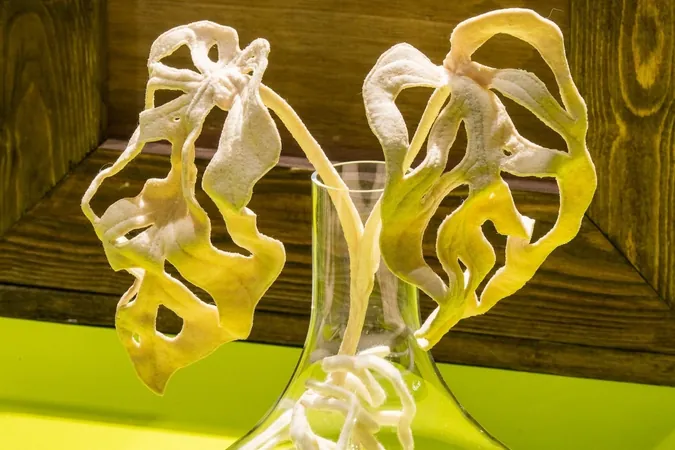
Edmonton Artist's Haunting White Felt Plants Challenge Nature and Consumer Culture
2025-01-04
Author: Jacob
Edmonton Artist's Haunting White Felt Plants Challenge Nature and Consumer Culture
Edmonton-based artist Taiessa has taken the art world by storm with a unique collection of houseplants meticulously crafted from white felt. These ghostly creations, which have garnered attention during the pandemic, are currently displayed in the storefront window of the Esker Foundation, a contemporary art space in Calgary. As people stroll through the vibrant Inglewood district, they are treated to a thought-provoking exploration of nature, value, and the implications of consumerism.
The Birth of a Unique Art Project
Taiessa's creative journey began during the COVID lockdown, when she found herself surrounded by an array of houseplants that had come to her through trades with friends, family, and strangers met online. With a passion for the green in her home, she began experimenting with sewing machines, channeling her artistic expression into her newfound project.
“I was just playing around, familiarizing myself with different sewing techniques,” she shares. “While it may seem like I possess extensive sewing skills, it really was about mastering this specific technique over time.”
Capturing Nature with Thread
Using a free-motion quilting foot, Taiessa meticulously studies her plant subjects, creating detailed sketches to understand their intricate leaf veining and textures. “I use thread almost like a drawing tool,” she explains, emphasizing the delicate process that brings her creations to life.
Initially invited to showcase her work at Latitude 53, an artist-run centre in Edmonton, the project quickly evolved beyond isolation into a year-long residency at the Harcourt House Artist Run Centre, where she produced a majority of her unique pieces.
Why White? The Story Behind the Color
The choice of white for her plants stems from Taiessa's intrigue with plant-buying trends, particularly those surrounding increasingly trendy variegated plants, such as monstera varieties with eye-catching cream and white splashes. “While I’m not a botanist, I learned that these areas lack chlorophyll—the component vital for plant survival,” she notes. This revelation sparked deeper reflections for Taiessa: how futile it seemed to cultivate plants that cannot naturally sustain themselves.
She dives into the complexities of our manipulation of nature, questioning the ethics of treating plants as mere house decorations when they originate from environments where they thrive.
Navigating the Market: A Reflection of Consumer Culture
Taiessa's fascination with the rising prices of these exotic plants—including some clippings soaring from over $100 to upwards of $700 during the pandemic—coincided with the difficulty of importing them due to shipping restrictions. Her artwork aims to draw parallels to historical themes of imperial expansion and resource exploitation, emphasizing how these trends have scant regard for the environment or the labor behind harvesting.
In the current exhibit at the Esker Foundation, the plants are displayed in crates, suggesting they’ve just arrived from an exotic location, making a stark contrast to their previous display in Victorian-style glass terrarium cases. “The crates serve as a modern reference to transport rather than just a display,” she notes.
Rethinking Luxury: The Ghostly Allure of Albino Plants
Reacting to the unsettling nature of her white plants, viewers often describe them as ghostly or reminiscent of bleached coral reefs. “I hear a lot of stories from people about their personal connections to plants, including heirloom plants that have been in their families for generations,” Taiessa shares. “Caring for plants can represent a different kind of exchange—one that goes beyond mere accumulation of wealth.”
When asked if she possesses any white plants herself, Taiessa reveals, “I did find one last fall; the price had dropped from $700 to just $60. They’ve even started appearing in local hardware stores.”
Taiessa's exhibit, "Variegata," is on display at the Esker Foundation until February 2, with works from the same series also featured in the upcoming group show "What We Leave, What We Take," celebrating the 100th anniversary of the Art Gallery of Alberta in Edmonton, opening March 8.
As Taiessa continues to challenge perceptions of nature and value through her artistry, her felt plants serve as a haunting reminder of our relationship with the natural world and the consequences of consumer culture. Don't miss the opportunity to engage with this timely and provocative exhibition!



 Brasil (PT)
Brasil (PT)
 Canada (EN)
Canada (EN)
 Chile (ES)
Chile (ES)
 Česko (CS)
Česko (CS)
 대한민국 (KO)
대한민국 (KO)
 España (ES)
España (ES)
 France (FR)
France (FR)
 Hong Kong (EN)
Hong Kong (EN)
 Italia (IT)
Italia (IT)
 日本 (JA)
日本 (JA)
 Magyarország (HU)
Magyarország (HU)
 Norge (NO)
Norge (NO)
 Polska (PL)
Polska (PL)
 Schweiz (DE)
Schweiz (DE)
 Singapore (EN)
Singapore (EN)
 Sverige (SV)
Sverige (SV)
 Suomi (FI)
Suomi (FI)
 Türkiye (TR)
Türkiye (TR)
 الإمارات العربية المتحدة (AR)
الإمارات العربية المتحدة (AR)